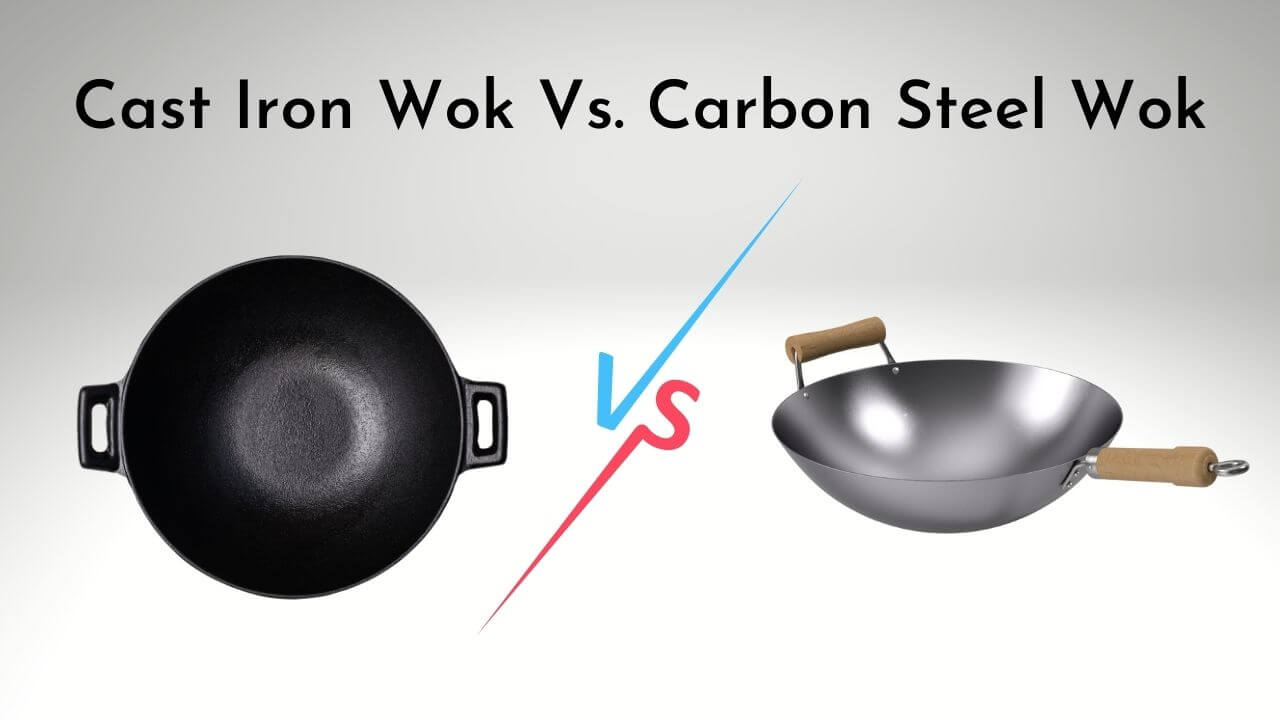Last Updated on May 19, 2023 by River Tree Farms
Woks are round pots that originated from China but were later brought to the United States. They are not only used traditionally but also in modern kitchens. Some of these pots come with lids for covering foods, especially steaming. Woks come in various materials, that as cast iron and carbon steel. Depending on your cooking needs, you might need the two Woks. This article has compiled both materials, their advantages and disadvantages, cleaning and maintenance, and their features.
Comparison Table between Cast Iron And Carbon Steel Wok
| Characteristic | Cast Iron Wok | Carbon Steel Wok |
|---|---|---|
| Material | Cast iron | Carbon steel |
| Heat retention | Excellent | Good |
| Heat distribution | Even | Even |
| Cooking surface | Rougher | Smoother |
| Durability | Extremely durable | Durable |
| Maintenance | Requires seasoning and regular oiling | Requires seasoning and occasional oiling |
| Weight | Heavy | Light-medium |
| Price | More expensive | Less expensive |
| Suitable for | Deep-frying, stir-frying, searing | Stir-frying, searing, sautéing |
| Compatible with | All stovetops, including induction | All stovetops including induction |
| Advantages | Retains heat for longer periods, retains heat even after turned off, adds flavor to food | Lightweight, heats up quickly, less prone to warping, easier to handle |
| Disadvantages | Heavy and difficult to handle, prone to rust, requires regular maintenance | Requires seasoning and occasional oiling, less heat retention than cast iron |
Cast Iron Wok features:
There are two types of cast iron wok: one from the west and the other from China. Woks made in the west are more expansive and intricate than those china make. The wok pots differ in their features, pros, and cons. Cast iron features include;
Heat retention
These pots are a mixture of carbon and iron. They retain heat, especially when cooking meat. The food cooked and stored in these pots will be warm even after several hours. Even after removing it from the fire, the food remains hot.
Non-stick
Ever noticed how hard it is scrubbing pots after cooking foods, and they stick? The cast iron wok pots contain a carbonized layer and do not stick unless you are preparing acidic foods. The surface is also enameled, which gives the surface a glossy surface.
Durable
The cast iron wok has lifetime durability due to the strong materials. If used and maintained correctly, you will pass it to the next generation while still in good condition.
Why is a cast iron wok better?
A cast iron wok is better as it reacts faster to heat and stores heat for more extended periods. Cleaning is also straightforward as it is non-stick and well-seasoned.
Cleaning and maintaining cast iron wok
Cleaning a cast iron wok involves warm water and a soft-bristle brush or a soft sponge. Do not use acidic substances to clean as it will damage the wok seasoning. You should not use metallic objects as they will scrape them up. After scrubbing, rinse it off with warm water to remove any food particles. Always ensure you season before the first use, even if it says pre-seasoned.
Advantages
- It retains heat for extended periods as it distributes heat evenly in the pot.
- Strong and durable. Due to the iron skillets, cast iron is very durable.
- It is perfect for roasting, baking, and frying.
- A well-seasoned cast-iron wok is easier to clean and does not stick.
- It is versatile.
Disadvantages
- Cast iron wok requires seasoning from time to time.
- Acidic foods cannot be prepared in the pot, like tomatoes as they will damage the seasoning.
- Poor conductors of heat. They react to heat very slowly, and even when cooking is done, they will continue cooking, causing overcooking.
- Very heavy compared to other metals like aluminum.
- The china-made pots are fragile and delicate and hence can break if dropped.
- Cast iron wok is very expensive due to the heavy materials used to produce it.
Carbon Steel Wok features:
Many people will prefer a carbon steel wok due to its affordability. In most kitchens, you will get this product. Whether you should buy carbon steel wok will depend on several features.
Better thermal conductivity
Due to its build quality, carbon steel has excellent heat distribution with even cooking of foods. It is fit for vegetable cooking, where you won’t have to worry about turning the foods repeatedly.
Light-weight
It is very light and responds to heat quickly. You won’t wait for minutes for your pot to heat before you start cooking. Most of these pots have wooden handles hence easy to handle.
Non-stick
A good pot should be non-stick to ease the work of scrubbing. Carbon steel wok has a non-stick surface and can be durable with proper maintenance.
Excellent heat distribution
The carbon steel wok detects heat fast and evenly distributes it to your food particles. There is even cooking of food as the heat is distributed evenly.
Why is a carbon steel wok better?
Many homes will prefer a carbon steel wok due to its affordability. Most homes cannot afford a cast iron wok because it’s expensive; therefore, they go with a carbon steel wok. It is also loved by far due to its lightweight nature. You can easily carry it around while traveling without fear of breaking it.
Cleaning and maintenance of carbon steel wok
Cleaning carbon steel work requires energy and a lot of time. It is also very corrosive due to the heat while cooking; to remove it, you will have to re-season the pot. Scrub all the inner parts well with a soft sponge and warm water to remove any food particles. Like a cast iron wok, you should not use any metallic substances to scrub as it will damage the wok. Do not wash the pots in a dishwasher. After cleaning, store it in a dry place if you don’t intend to use it immediately.
Pros of Carbon steel wok
- It is very affordable, and most families can own the carbon steel wok.
- It is very lightweight and hence easy to use and carry around.
- Due to its non-stick feature, there is a reduction in butter and oil usage. The smooth surface also makes cooking very easy and fun.
- It has a marvelous design that completes your kitchen look.
- It heats up faster and cools down quickly; hence foods are not overcooked.
- It is perfect for frying and broiling.
Cons of carbon steel wok
- Seasoning should be done even before your first time cooking with the pot to make it non-stick.
- It is very reactive with acidic foods.
- It is very corrosive and wears out in a short period.
- Maintenance requires a lot of time and energy and should be done consistently.
- The handles can get hot.
Which is better: Cast iron wok or carbon steel wok?
After comparing the features, advantages, and disadvantages, the best wok for you will depend on the purpose. Every wok has pros and cons, so figure out which suits you best before buying. The cost of buying is also a factor, if you need an affordable wok, carbon steel is better, but its life period is low and requires a lot of maintenance and cleaning. For any work you choose, check all features, compare them and decide which one to buy. Alternatively, you can get both woks as they will serve different purposes when cooking is involved. You can get a carbon steel wok for frying and a cast iron for roasting and baking.
Cast Iron Vs Carbon Steel Wok health
A carbon steel wok is not suitable for your health, especially its corrosive nature. Carbon steel and cast iron are reactive with acidic foods because they contain stainless steel metals. When cooked for more extended periods can cause food poisoning. A cast iron wok can leach into food and can harm your health in high percentages. Seasoning the cookware will reduce the metallic taste.
Conclusion
The debate on which is the best from cast iron and carbon steel wok continues with no single agreement being reached. The best cookware for you will depend on the features, pros, and cons. Before buying any of the two, determine what you need and if the pot has the necessary parts. Need I to remind you that cheap is always expensive.

